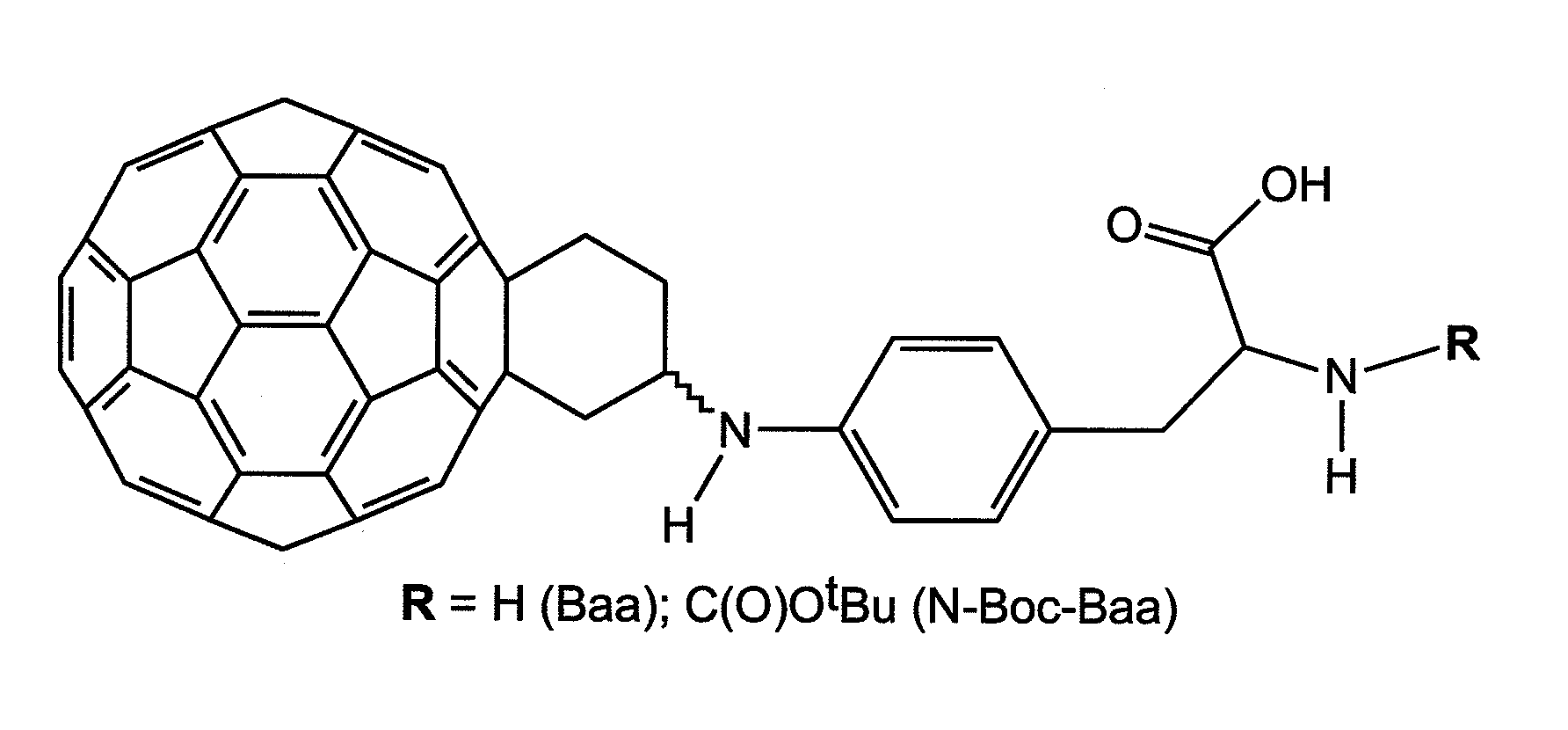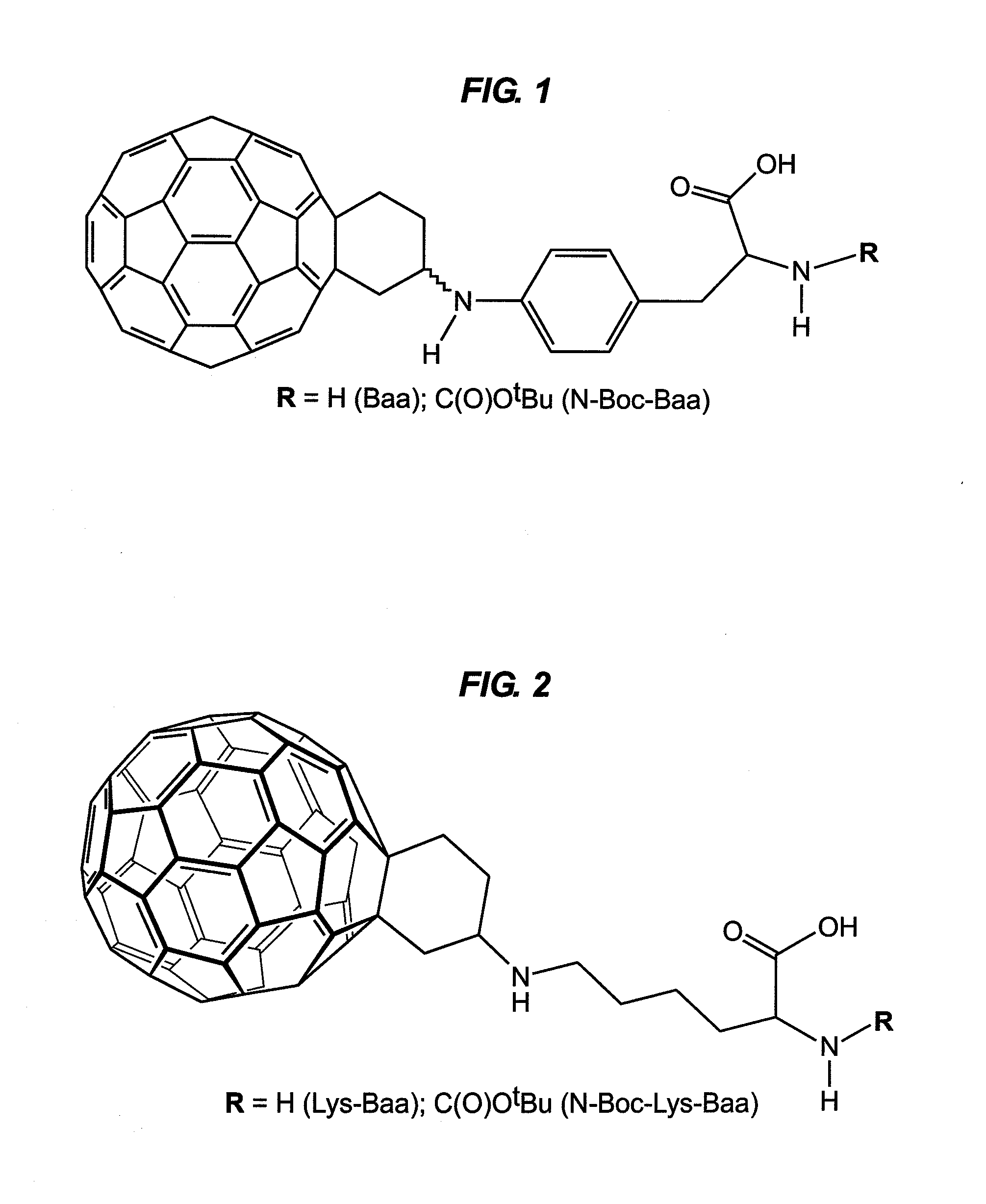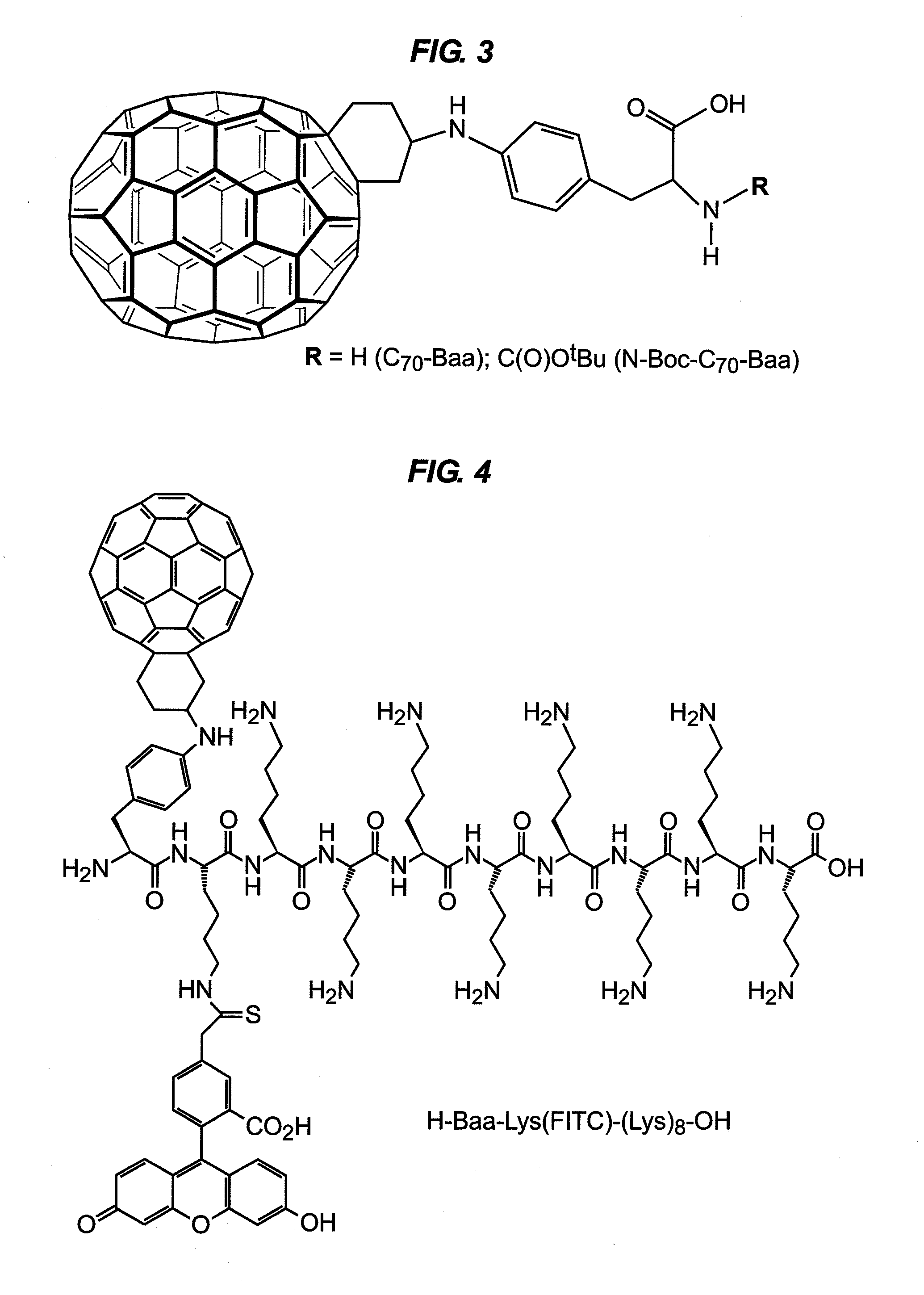Fullerene Assisted Cell Penetrating Peptides
a technology of peptides and fullerene, which is applied in the field of intracellular delivery, can solve the problems of limited success in spps synthesis of fullerene amino acids and the limitation of subsequent incorporation into peptides
- Summary
- Abstract
- Description
- Claims
- Application Information
AI Technical Summary
Benefits of technology
Problems solved by technology
Method used
Image
Examples
example 1
[0053]Glu-Ile-Ala-Gln-Leu-Glu-Baa-Glu-Ile-Ser-Gln-Leu-Glu-Gln-NH2 (21). The coupling of the first 6 residues was carried out on an automated APEX 396 Multiple Peptide Synthesizer (Advanced ChemTech) under nitrogen flow using a rink amide resin (430 mg, 0.3 mM) as the solid phase. Each coupling uses four-fold excess of the amino acid, and HBTU, HOBt as activators and DIEA as base in a 1:1:1:3 ratio. Fmoc deprotection was performed using 25% piperidine in DMF solution. After the deprotection of the sixth residue (Glu), one sixth of the resin (ca. 0.05 mM) was placed in a 25 mL fritted glass tube, and swollen with DMF (ca. 10 mL). A 3-fold excess of Fmoc-Baa was dissolved in DMF / DCM (2:1) (9 mL) in a second glass vial. The Fmoc-Baa solution was first activated with PyBOP / HOBt / DIEA (1:1:1:2) for 2 minutes, then mixed with the resin in the fritted glass tube, and shaken on an automated shaker for 1 day at room temperature. Then the resin was washed thoroughly with DMF and DCM to remove u...
example 2
[0054]Baa-Glu-Ile-Ala-Gln-Leu-Glu-Tyr-Glu-Ile-Ser-Gln-Leu-Glu-Gln-NH2 (22). The solid phase synthesis of fullero-peptide 22 was carried out on an automated APEX 396 Multiple Peptide Synthesizer (Advanced ChemTech) under nitrogen flow. Rink amide resin (430 mg, 0.3 mM) was used as solid phase. Each coupling uses 4 fold amino acid excess, and HBTU, HOBt as activators and DIEA as base in a 1:1:1:3 ratio. Fmoc deprotection was performed using 25% piperidine in DMF solution. After the deprotection of the eighth residue (Glu) was finished, one sixth of the resin (ca. 0.05 mM) was moved out to a 25 mL flitted glass tube, swollen with DMF and a 3-fold excess of BocBaa (157 mg, 0.15 mmol) was dissolved in DMF / DCM (2:1, 9 mL). The Boc Baa solution was first activated with PyBOP / HOBt / DIEA (1:1:1:3) for 2 minutes. The activated Boc-Baa was mixed with the resin in the flitted glass tube, and shaken on an automated shaker for 1 day at room temperature. Then the resin was washed thoroughly with DM...
example 3
[0055]Baa-Glu-Ile-Ala-Gln-Leu-Glu-Tyr-Glu-Ile-Ser-Gln-Leu-Glu-Gln-Glu-Ile-Gln-Ala-Leu-Glu-Ser-NH2 (23). The solid phase synthesis of fullero-peptide 23 was carried out on an automated APEX 396 Multiple Peptide Synthesizer (Advanced ChemTech) under nitrogen flow. Rink amide resin (430 mg, 0.3 mM) was used as solid phase. Each coupling uses 4 fold amino acid excess, and HBTU, HOBt as activators and DIEA as base in a 1:1:1:3 ratio. Fmoc deprotection was performed using 25% piperidine in DMF solution. After the deprotection of the eighth residue (Glu) was finished, one sixth of the resin was moved out to a 25 mL flitted glass tube, swollen with DMF and a 3-fold excess of BocBaa (157 mg, 0.15 mmol) was dissolved in 9 mL DMF / DCM (2:1). The Boc-Baa solution was first activated with PyBOP / HOBt / DIEA (1:1:1:3) for 2 minutes. The activated Boc Baa was mixed with the resin in the flitted glass tube, and shaken on an automated shaker for 1 day at room temperature. Then the resin was washed thoro...
PUM
| Property | Measurement | Unit |
|---|---|---|
| path-length | aaaaa | aaaaa |
| time | aaaaa | aaaaa |
| time | aaaaa | aaaaa |
Abstract
Description
Claims
Application Information
 Login to View More
Login to View More - R&D
- Intellectual Property
- Life Sciences
- Materials
- Tech Scout
- Unparalleled Data Quality
- Higher Quality Content
- 60% Fewer Hallucinations
Browse by: Latest US Patents, China's latest patents, Technical Efficacy Thesaurus, Application Domain, Technology Topic, Popular Technical Reports.
© 2025 PatSnap. All rights reserved.Legal|Privacy policy|Modern Slavery Act Transparency Statement|Sitemap|About US| Contact US: help@patsnap.com



